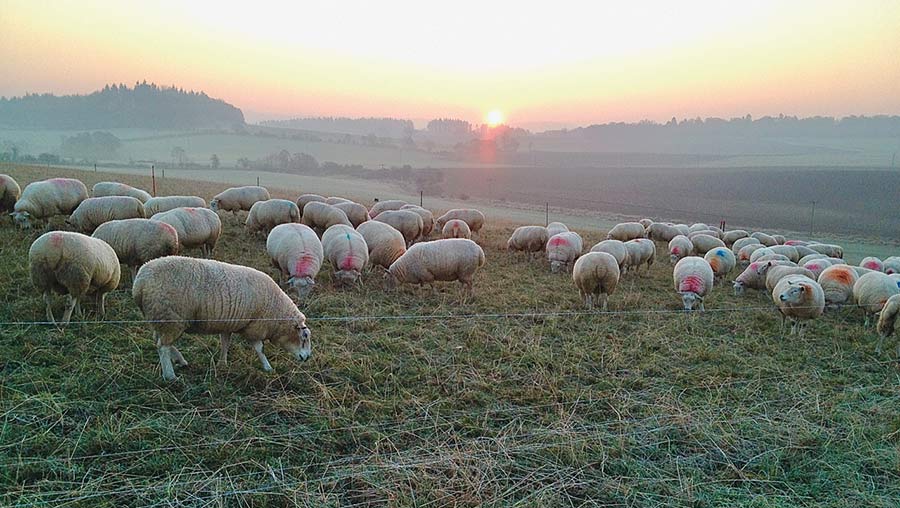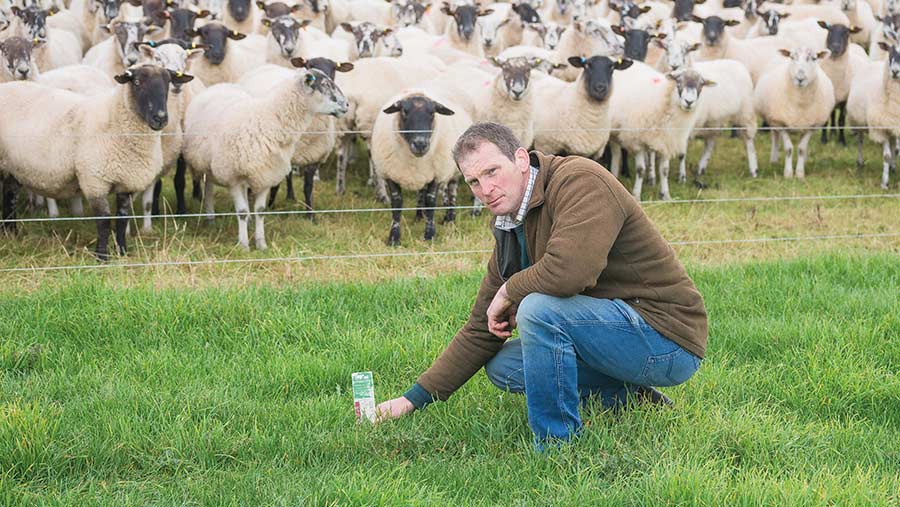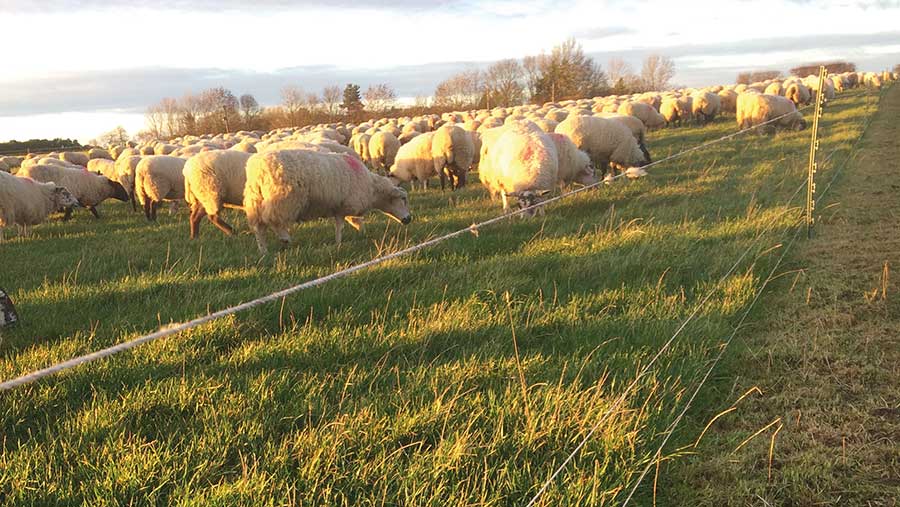How to budget and allocate rotational grazing for ewes
 Wintering ewes mid-pregnancy © Emily Grant
Wintering ewes mid-pregnancy © Emily Grant Preparing a grazing budget and assigning pasture on a rotational basis can significantly boost grass growth and a farm’s overall productivity.
When managing a flock of ewes, these tools offer the scope to allocate pasture to groups according to their body condition score (BCS), lambing date and how many lambs they are carrying.
This approach gives producers better control of their grass, potentially allowing them to eke out well-managed autumn growth over winter, and even through to spring.
Winter can be a good time for rotational grazing newcomers to put a toe in the water – while ewes are in mid-pregnancy and before grass growth takes off.
It is also the time when nutrition becomes critical as ewes approach their third trimester.
See also: How to work out ewe efficiency and what it can tell you
Nutrition in late gestation
Nutritional needs should take priority, according to independent beef and sheep consultant Emily Grant.
She says that although well-managed grazing can be sufficient for some ewes in some situations, late gestation is the time when supplementation may be needed.
“It is possible for grazed grass to meet the nutritional demands of the third trimester, but the focus should be on ewe condition and having sufficient grass covers to lamb on to,” she says.
After a mid-trimester focused on feeding the ewe for maintenance, she says the final trimester sees the biggest change in nutritional requirements.
“You need to have your ducks in a row as this increase in demand happens when you’re not necessarily getting much pasture growth,” she says.
“So, we should not be afraid to use supplementary feeding, whether that’s with silage or concentrates, but it should be supported by a grazing plan, to make the best possible use of the farm’s cheapest feed resource.”
This plan involves an assessment of how much pasture is available and allocating it according to stock requirements. This requirement reflects the number and liveweight of animals and their predicted intakes.
The process can be assisted using various packages, ranging from simple spreadsheets from AHDB and Quality Meat Scotland (QMS) to more sophisticated apps such as Feedsmart, which can be adjusted for stage of pregnancy.
“The ewes’ requirements should be based on a percentage of their weight and not an absolute figure,” says Mrs Grant.
“While 1.2kg dry matter (DM) intake/day may be sufficient for a 65kg ewe carrying a single lamb in the final trimester, if she’s 80kg, it will not be enough.”
As a rule of thumb, she says DM intakes in late gestation should range from 1.6% to 2.5% of bodyweight. However, feed quality and litter size will affect this calculation (see table below).
Intake requirements can also increase in cold, windy conditions and utilisation can decrease in wet weather.
If the feed offered is grass, then knowing its quality will help with the accuracy of its allocation.
“If you are unsure, it’s worth having grass analysed, but you can usually make a judgement based on prior knowledge and whether it’s green and leafy or has a lot of dead matter,” she says.
“It’s possible to have a metabolisable energy [ME] of over 11MJ/kg DM during winter, if the pasture is leafy green, but if there is a lot of dead matter and stem, it will probably be below 10.5ME.
“Quality can change in the face of very cold or wet conditions and as the time between closing off a paddock and grazing increases.”
Assessing nutritional needs
While ewes carrying multiple lambs will have the highest priority, BCS is also critical in assessing nutritional needs. A stable BCS of 3-3.5 throughout pregnancy will optimise ewe and lamb survival and lamb growth rates.
“The greatest production gains will come through reducing the number of ewes with BCS below target,” says Dr Grant.
“However, moving above the target range offers no benefits as inefficiencies enter the system as well as potential metabolic issues.
“Knowing BCS helps drive successful feeding, so I’d recommend scoring ewes at scanning and at any other opportunity when handling ewes ahead of lambing,” she adds.
Maintaining their condition using well-managed grazing will cut costs of production and improve financial success.
Daily feed requirements from scanning to lambing adjusted for pasture quality and scanning results |
|||
| kg DM a ewe a day for a 65kg ewe (% of bodyweight) | |||
|
Feed quality |
Single lamb |
Twins |
Triplets |
|
Low |
1.2 (1.8%) |
1.5 (2.2%) |
1.6 (2.5%) |
|
High |
1.1 (1.6%) |
1.3 (2%) |
1.5 (2.2%) |
| Source: AHDB Planning grazing strategies for better returns. Figures calculated using SRUC Feedbyte rationing software | |||
Further resources:
Case study: Westerheugh Farm near Newcastle

Alan Cowan © Robert Smith
Using a grazing budget has allowed Alan Cowan to increase his ewe numbers from 800 to 1,000, cut 40t/year from his concentrate use and achieve an almost complete reliance on grazed grass on his 170ha (420-acre) Northumberland farm.
His aim is to carry the pregnant ewes through the winter on rotational grazing, but always with a contingency plan for the onset of bad weather.
At the end of November, the grass was analysed with metabolisable energy (ME) of 11.6-12MJ/kg dry matter (DM) and 18.6-22% protein.
The system depends on closing the winter grazing platform in late August/early September to build a grass wedge before stock return to these fields on 1 December.
During the autumn, ewes have plenty of high-quality grazing five days before and during tupping. They are offered the pick of the leaf and grass quality and achieve a body condition score (BCS) of at least 3.
After this they move to 4ha (10 acre) paddocks that are subdivided into 0.4ha (1 acre) cells, using polywire reeled with an ATV winder.
Ewes, weighing around 65kg, are budgeted at this early- to mid-gestation stage to eat 1kg DM a day.
The whole flock is scored for condition three weeks after the start of the winter grazing rotation. The entire flock remains on each cell for one day, except for a handful of ewes that have dropped condition.
These are moved on to a different field and may be given concentrates.

Ewes on new cell by previous day’s residual © Alan Cowan
From December until scanning, the flock remains on maintenance intakes only, taking residuals to as low as 1,000kg DM/ha.
After scanning, on 1 February, ewes are grouped according to lambing date, BCS and whether they are carrying singles, twins or triplets.
Those with a BCS below 2.5, carrying triplets or in the early lambing group are put on preferential grass, to give them a DM intake of 1.2kg/day (up to 6kg freshweight).
Twin-bearing ewes due to lamb from day 12-17 of lambing will receive 1.1kg DM/day. Singles are moved inside and on to a limited intake of hay to keep birth size down.
For the final 35 days of pregnancy DM is lifted to 1.4kg/day for ewes carrying twins and triplets by moving them on to larger cells for three days at a time, although entry covers at this stage are only about 2,000kg/ha.
Lambing is scheduled to begin outside on 1 April. In case of bad weather forcing a move indoors, a small amount of high-quality concentrate may also be fed (less than 0.4kg/head every three days) to help prepare the rumen for an indoor diet, alongside high-quality hay or silage.
This article forms part of the AHDB Grass Campaign, which aims to help producers make better use of home-grown grass swards, both grazed and conserved. Alan Cowan is a grass mentor for AHDB’s North East Strategic Farm (Beef & Lamb).
